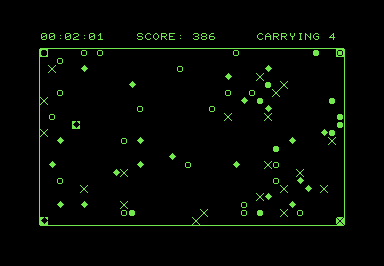CURSOR #12 – July 1979

COVER
Author: Glen Fisher
Original file name: COVER12
PRG file: cover12.prg
This month's cover is called SYMMETRY. The PET cycles through a series
of randomly-generated symmetrical designs drawn with the "rounded box" PETSCII characters.
This cover effectively shows off the creative potential of PETSCII. Many of the designs are quite
pretty, including several that
resemble flowers.
Pressing SPACE takes you to the table of contents for the issue.

CANYON!
Author: Larry Stevens
Original file name: CANYON!
PRG file: canyon.prg
CANYON! is a game where you have to manoeuvre your ship down the center of an
endlessly scrolling, gradually narrowing track without touching the sides. The canyon walls
scroll upward (following the natural scrolling direction of the PET), so you feel like you
are flying downwards. The game is far too easy on anything other than the fastest speed, and
even then, it feels too easy.
Joystick control is an option for this game. CANYON! also features sound, but
as far as I can tell, the only sound that plays is when you crash your ship.

GAUSS
Author: Glen Fisher
Original file name: GAUSS!
PRG file: gauss.prg
GAUSS! simulates a binomial distribution experiment. PETSCII balls are released
from the left edge of the screen and bounce randomly through a pegboard to land in one of the
twelve containers on the right. The PET keeps track of the results. This simulation is slow:
it runs in BASIC and the animations slow it down even more, so it runs at a rate of 1,000 balls per hour.
If you want to see interesting results, you'll need to leave this one running for a while.
This program has sound, because, according to the flyer, "a PET without sound is like a day without
sunshine". GAUSS! uses frequency to represent the height of each ball with high and
low "beeps" sounding every time a ball strikes a peg or lands in a slot. After a few iterations,
the novelty of the sound effects wore off—to be brutally honest, I found the beeps annoying.
Fortunately, Fisher provides a hotkey that mutes the simulation.

PICKUP
Author: Larry Phillips
Original file name: PICKUP
PRG file: pickup.prg
In PICKUP, you move around a cluttered screen picking up matching PETSCII
symbols and returning them to one of the goal squares in the corners. Control with the
numeric keypad is tricky but according to the flyer, control with the joystick (optional)
is even trickier. You can control the speed and time limit for the game. Blitz mode
(maximum speed, one minute time limit) is a real challenge. Be prepared to embrace
imperfection.

PIEGRAM
Author: Sheila Dolgowich
Original file name: PIEGRAM
PRG file: piegram.prg
PIEGRAM is not a pie chart graphing program; it is a "hide and seek" game
where you and the PET take turns taking shots at each other as you move around a 10x10
grid. For each shot you take, the computer reports the distance to the target of your
three most recent shots. If you have a good handle on the Pythagorean theorem, you should
be able to zero in on your quarry efficiently. The computer isn't especially smart either.
I was sure it had me cornered at one point—two shots in a row landed 1 square
diagonally adjacent to my position but the PET failed to take advantage of that information.
The title screen credits the author as SHELIA DOLGOWICH but the flyer correctly
identifies her as "Sheila", who was also the author of
WIPEOUT
in Issue #11.

FLIGHT!
Author: Ken Morley
Original file name: FLIGHT!
PRG file: flight.prg
FLIGHT! brings something new to CURSOR: a little "movie" with animation and
sound. This program tells the story of a Canadian moon landing. The author was from Vancouver,
so he's showing a little home-town bias here. The movie is simple but showcases creative applications
of the PETSCII character set. I remember being enthralled by this program in the early 1980s.
Although it may be a little slow for modern tastes, this one's still worth a watch today.
